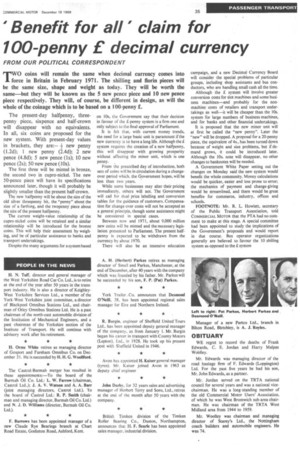' Benefit for all' claim for 100-penny E decimal currency
Page 37

If you've noticed an error in this article please click here to report it so we can fix it.
FROM OUR POLITICAL CORRESPONDENT
"TWO coins will remain the same when decimal currency comes into 1. force in Britain in February 1971. The shilling and florin pieces will be the same size, shape and weight as today. They will be worth the same—but they will be known as the 5 new pence piece and 10 new pence piece respectively. They will, of course, be different in design, as will the whole of the coinage which is to be based on a 100-penny £.
The present-day halfpenny, threepenny piece, sixpence and half-crown will disappear with •no equivalents. In all, six coins are proposed for the new system. With present-day values in brackets, they are:— + new penny (1.2d); 1 new penny (2.4d); 2 new pence (4.8d); 5 new pence (1s); 10 new pence (2s); 50 new pence (10s).
The first three will be minted in bronze, the second two in cupro-nickel. The new 50-pence piece will have its specifications announced later, though it will probably be slightly smaller than the present half-crown.
The new halfpenny will be about the size of the old silver threepenny bit, the "penny" about the size of a farthing, and the twopenny piece about the size of the present halfpenny.
The current weight-value relationship of the cupronickel coins will be retained and a similar relationship will be introduced for the bronze coins. This will help their assessment by weighing, and be of particular assistance to banks and transport undertakings.
Despite the many arguments for a system based on 10s, the Government say that their decision in favour of the £-penny system is a firm one and only subject to the final approval of Parliament.
It is felt that, with current money trends, the need for a large basic unit is paramount if the new currency is to have a long life. Although the £ system requires the creation of a new halfpenny, this will disappear with growing prosperity without affecting the minor unit, which is one penny.
From the prescribed day of introduction, both sets of coins will he in circulation during a changeover period which. the Government hopes, will be less than two years.
While some businesses may alter theft pricing immediately, others will not. The Government will call for dual price labelling and conversion tables for the guidance of customers. Compensation for change-over costs will not be accepted as a general principle, though some assistance might be considered in special cases.
Between now and 1971, about 9,000 million new coins will be minted and the necessary legislation presented to Parliament. The present halfpenny is expected to be withdrawn from the currency by about 1970.
There will also be an intensive education campaign, and a new Decimal Currency Board will consider the special problems of particular groups, including shop assistants and bus conductors, who are handling small cash all the time.
Although the £ system will involve greater conversion costs for slot machines and some business machines—and probably for the nonmachine costs of retailers and transport undertakings as well—it will be cheaper than the 10s. system for large numbers of business machines, and for banks and other financial undertakings.
It is proposed that the new minor unit will at first be called the "new penny". Later the "new" will be dropped. A proposal for a 20-penny piece, the equivalent of 4s., has been turned down because of weight and size problems, but &demand grows, it could be introduced later. Although the 10s. note will disappear, no other changes to banknotes will be needed.
A Government White Paper setting out the changes an Monday said the new system would benefit the whole community. Money calculations would be quicker, easier and less prone to error; the mechanics of payment and change-giving would be streamlined, and there would be great benefitsfor commerce, industry, offices and schools.
FOOTNOTE: Mr. R. L. Howlett, secretary of the Public Transport Association, told COMMERCIAL MOTOR that the PTA had no comment to make at this stage. A special committee had been appointed to study the implications of the Government's proposals and would report in due course. Bus operator organizations generally are believed to favour the 10 shilling system as opposed to the £ system




























































































































